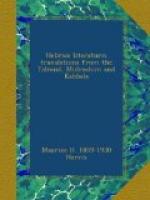The rose grows among thorns.
Two pieces of coin in one bag make more noise than a hundred.
The rivalry of scholars advances science.
Truth is heavy, therefore few care to carry it.
He who is loved by man is loved by God.
Use thy noble vase to-day; to-morrow it may break.
The soldiers fight and the kings are heroes.
Commit a sin twice, it will seem a sin no longer.
The world is saved by the breath of the school children.
A miser is as wicked as an idolater.
Do not make woman weep, for God counts her tears.
The best preacher is the heart; the best teacher time;
the best book the world; the best friend God.
The philosophy in the Talmud, rather than the philosophy of it, has been made the subject of separate treatment just as the whole of the Agada has been drawn out of the Talmud and published as a separate work.
What is the Talmud to the Jew to-day? It is literature rather than law. He no longer goes to the voluminous Talmud to find specific injunction for specific need. Search in that vast sea would be tedious and unfruitful. Its legal portion has long been codified in separate digests. Maimonides was the first to classify Talmudic law. Still later one Ascheri prepared a digest called the “Four Rows,” in which the decisions of later Rabbis were incorporated. But it was the famous Shulchan Aruch (a prepared table) written by Joseph Caro in the sixteenth century, that formed the most complete code of Talmudic law enlarged to date, and accepted as religious authority by the orthodox Jews to-day.
I have already referred to the literature that has grown out of the Talmud. The “Jewish Encyclopedia” treats every law recognized by nations from the Talmudic stand-point. This will give the world a complete Talmudic point of view. In speaking of it as literature, it lacks perhaps that beauty of form in its language which the stricter demand as literature sine qua non, and yet its language is unique. It is something more than terse, for many a word is a whole sentence. Written in Aramaic, it contains many words in the languages of the nations with whom Israel came in contact—Greek, Roman, Persian, and words from other tongues.
Like the Jew, the Talmud has had a history, almost as checkered as that of its creator. Like him it was singled out for persecution. Louis ix. burned twenty-four cart-loads of Talmuds in Paris. Its right of survival had often been wrested through church synods and councils. It has been banned, it has been excommunicated, it has been made the subject of popish bulls; but it was in the sixteenth century that the Benedictine Monks made a particular determined effort to destroy it. Fortunately they knew not the times. It was the age of Humanism, the forerunner of the Reformation, and the Talmud found its ablest defender in the great Christian humanist, John Reuchlin. He was the one first to tell his co-religionists, “Do not condemn the Talmud before you understand it. Burning is no argument. Instead of burning all Jewish literature, it were better to found chairs in the universities for its exposition.” The cause of liberality and light gained the day, and the printing-press decided the perpetuation of the Talmud.




